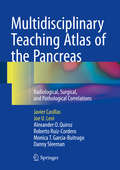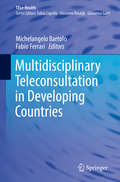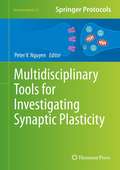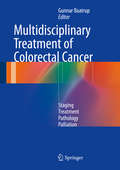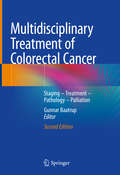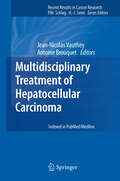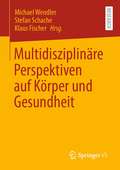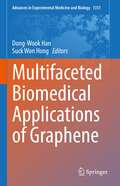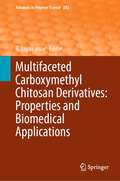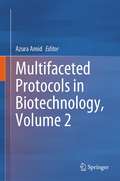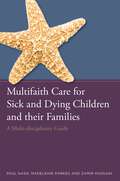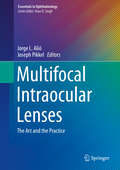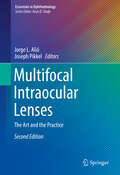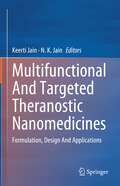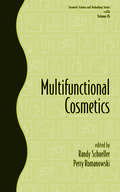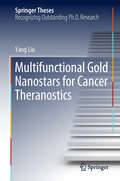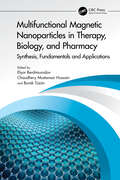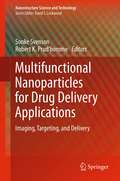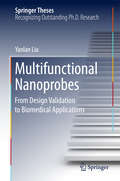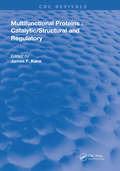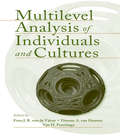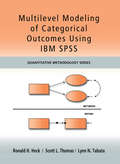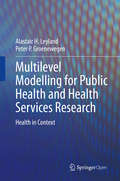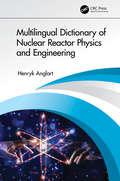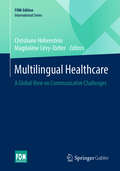- Table View
- List View
Multidisciplinary Teaching Atlas of the Pancreas
by Javier Casillas Joe U. Levi Alexander O. Quiroz Roberto Ruiz-Cordero Monica T. Garcia-Buitrago Danny SleemanThis innovative teaching atlas provides the reader with a practical approach to the diagnosis and management of the common and uncommon diseases that may involve the pancreatic gland. Its perspective is multidisciplinary, the authors being radiologists, surgeons, pathologists, and gastroenterologists who have worked together for the past 25 years. Very concise descriptions of clinical presentation, pathology, imaging, and management are provided for a great variety of pathologic conditions, and a wealth of illustrative material displays intraoperative appearances, gross specimens, histology, and radiological findings. Pancreatic surgery, including transplantation, is also discussed, and the final chapter presents a gallery of challenging and diverse cases. Specialists and residents in a range of specialties will find this atlas to be an invaluable aid, and it will also serve as an excellent reference for medical students.
Multidisciplinary Teleconsultation in Developing Countries (Tele-health Ser.)
by Michelangelo Bartolo Fabio FerrariThis book presents a replicable model of multidisciplinary teleconsultation, designed and set up by Global Health Telemedicine, that offers very significant health benefits in remote and rural areas of developing countries. The model is based on experiences gained in sub-Saharan Africa while training and cooperating with local health professionals within the DREAM program, managed by the Community of Sant’Egidio. This program has to date treated almost 300,000 patients across many countries and has provided health education and disease prevention training to tens of millions. It originated in the context of the fight against AIDS but has been extended to encompass other pathologies and to exploit the capabilities of new telemedicine technologies that allow multispecialist teleconsultation (hence the acronym now represents “Disease Relief through Excellent and Advanced Means”). In addition to thorough description of the program, readers will find reflections and analysis on logistical, technical, sociological, and epidemiological issues. The book is divided into thematic chapters with easy-to-understand graphics. It will be a readily accessible source of information for professionals in international cooperation and global health students and professionals.
Multidisciplinary Tools for Investigating Synaptic Plasticity
by Peter NguyenInvestigations involving incisive mechanistic dissection of various types of synaptic plasticity have revealed that it plays key roles in neural development, sensory information processing, cortical remapping following brain injury, perception, and behavioral learning and memory. Disruptions of synaptic plasticity may underlie neurological and behavioral disorders such as Alzheimer disease, Fragile-X syndrome, autism, and drug addiction. Multidisciplinary Tools for Investigating Synaptic Plasticity, therefore, assembles expert contributions that highlight techniques and strategies used in probing the cellular and molecular mechanisms of synaptic plasticity in the nervous systems of vertebrate and invertebrate species. Divided into three sections, this meticulous volume describes biochemical and genetic strategies for studying synaptic plasticity, behavior, neural development, and synaptogenesis, and also includes cellular electrophysiological and optical methods for interrogating a diverse array of mechanistic issues. As part of the Neuromethods series, this book contains the kind of detail and key implementation advice that maximizes successful results. Authoritative and invaluable, Multidisciplinary Tools for Investigating Synaptic Plasticity serves as an ideal primer for introducing researchers to specific techniques that will enhance their success at addressing novel questions in synaptic plasticity at the lab bench.
Multidisciplinary Treatment of Colorectal Cancer
by Gunnar BaatrupThis book is intended as the equivalent of the Swiss Army knife for all members of colorectal cancer (CRC) multidisciplinary teams and those training in the fields of CRC management. It describes how to organize the team and explains the basic principles within the different disciplines involved in the treatment and care of CRC patients. Important, up-to-date knowledge is provided on visualization techniques, surgery, oncological treatment, palliation, and pathology, with special focus on controversies and aspects of interest to all team members. Care has been taken to ensure that each specialty-specific chapter will be approachable for team members from other specialties or professions, thereby facilitating an effective interdisciplinary approach to teamwork. The authors include leading European doctors and scientists who have influenced the development of the multidisciplinary team concept as well as other aspects of high-quality, individualized treatment of CRC patients.
Multidisciplinary Treatment of Colorectal Cancer: Staging – Treatment – Pathology – Palliation
by Gunnar BaatrupThis book is a comprehensive reference work on the multidisciplinary team (MDT) management of colorectal cancer (CRC) patients that will meet the needs of all members of CRC MDTs and those training in the field. Important, up-to-date knowledge is provided on organization of MDTs, early intervention, surgery, oncology, imaging, pathology, and palliation, with special focus on controversies. This second edition has been thoroughly revised. It includes an entirely new section on the principles of treatment of significant polyps and early cancers and a total of 14 new chapters, including one on the early integration of palliative care. Every effort has been made to ensure that each specialty-specific chapter will be approachable for all team members, thereby facilitating an effective interdisciplinary approach to teamwork. The authors are leading European doctors and scientists who have influenced the development of the MDT concept as well as other aspects of individualized treatment of CRC patients.
Multidisciplinary Treatment of Hepatocellular Carcinoma
by Jean-Nicolas Vauthey Antoine BrouquetIt is now widely accepted that multidisciplinary collaboration and multimodality treatment approaches are important in improving the survival of patients with hepatocellular carcinoma. In this comprehensive textbook, internationally renowned experts in the field present and discuss the various strategies employed in the treatment of the disease. Up-to-date information is provided on the indications for and outcome of a range of treatment options, including surgical resection, liver transplantation, radiofrequency ablation, transarterial chemoembolization, yttrium-90 transarterial radioembolization, and systemic therapy. In addition, important background information is included on biology, pathology, staging, and imaging. This book will be particularly helpful to all professionals and trainees worldwide who have an interest in the diagnosis and treatment of hepatocellular carcinoma.
Multidisziplinäre Perspektiven auf Körper und Gesundheit
by Michael Wendler Klaus Fischer Stefan SchacheDie Begriffe Körper und Gesundheit sind (nicht erst) seit dem sogenannten body-, corporeal- oder somatic-turn Gegenstand sehr unterschiedlicher Disziplinen und Perspektiven: Die Komplexität der Zusammenhänge, Verschränkungen, Bedingungen des Gegenstandspaares Körper-Gesundheit bis hin zur Identifikation macht es erforderlich, multidisziplinär und multiperspektivisch vorzugehen. In diesem Band sind unterschiedliche Disziplinen und Perspektiven versammelt, die sich aus ihrer Fachgenese und wissenschaftlichen Position heraus mit Körper, Leib und Gesundheit beschäftigen, um v.a. Forschungsfelder zu erschließen und praxeologische Konsequenzen zu benennen.
Multifaceted Biomedical Applications of Graphene (Advances in Experimental Medicine and Biology #1351)
by Dong-Wook Han Suck Won HongThis book explains the fundamental characteristics and biofunctionality of graphene-based nanomaterials and provides up-to-date information on the full range of their biomedical applications. An introductory section gives an overview of the chemical composition and physical properties of graphene and its derivatives as well as their potential toxicity and biosafety. Detailed attention is then devoted to the potential of multifunctional graphene-based nanomaterials (MFGNs) to direct the differentiation of stem cells into specific lineages and induce tissue regeneration. Here, individual chapters address the application of MFGNs for the purposes of neurogenesis, osteo- and chrondrogenesis, myogenesis, and wound healing. Subsequent sections focus on the capability of MFGNs as agents for drug delivery, bioimaging, theranostics, and therapeutics as well as their effectiveness as biomimetic platforms for nanobiosensors, biochips, medical devices, and dental applications. The book will be essential reading for graduate students, scientists, and engineers in any of the biomedical research fields in which efforts are being made to utilize novel MFGN-incorporated composite materials and develop functional devices based on them.
Multifaceted Carboxymethyl Chitosan Derivatives: Properties and Biomedical Applications (Advances in Polymer Science #292)
by R. JayakumarThis edited collection deals with the structure-property relationships and biomedical applications of carboxymethyl chitosan derivatives in different fields. Readers will detailed overview of the preparatory methods involved in the derivatives of carboxymethyl chitosan and its interaction with metal ions. The chapters provide a detailed overview of the different types of carboxymethyl chitosan derivatives, including the preparatory methods involved, the interactions with metal ions, and the antimicrobial activities. These different forms of carboxymethyl chitosan derivatives are found to be potentially used in food packaging, in enhancing saltiness, as biosensors, and also as wound dressing. Chapters are also devoted to the fabrication and biomedical applications of carboxymethyl chitosan derivatives-based nanofibers as well as the interaction of carboxymethyl chitosan with blood in blood clotting and the underlying mechanism. Contributing authors additionally explore topics related to carboxymethyl chitosan-based hydrogels, films, scaffolds, fibers, and composites. Finally, this volume presents the current challenges in developing biomedical products based on carboxymethyl chitosan derivatives. This book will be of interest not only to chemists, but to all scientists working in the fields of material/environmental science, biological science, and biomaterials. These chapters are great resources for any researcher who works with structure-property relationships, biological interactions, and the applications of carboxymethyl chitosan derivatives in different biomedical fields.
Multifaceted Protocols in Biotechnology, Volume 2
by Azura AmidThis contributed volume, “Multifaceted Protocols in Biotechnology, Volume 2”, consists of multidisciplinary methods and techniques commonly used in biotechnology studies. There are two sections covered in this book – Ionic Liquid Related Techniques & Evergreen Biotechnology Techniques. A brief introduction supports each protocol to allow easy learning and implementation. The first section consists of three chapters covering studies in modern biotechnology focusing on the role of ionic liquid techniques in extracting secondary metabolites, enzyme stabilization and biomass processing. The second section covers evergreen methodologies. It comprises five chapters covering topics on microcarrier technology for cell culture; Polymerase Chain Reaction for non-halal sources detection in food; ELISA for biomarker identification; gamma ray-induced mutagenesis for enhancing microbial fuel cells; and the effect of temperature on antibacterial activity of Carica papaya seed extract. This book will be useful to graduate students, researchers, academics, and industry practitioners working in the area of biotechnology
Multifaith Care for Sick and Dying Children and their Families: A Multi-disciplinary Guide
by Paul Nash Keith Munnings Rakesh Bhatt Claire Carson Zamir Hussain Parkash Sohal Naomi Kalish Kusumavarsa Hart Madeleine Parkes Surinder SidhuWhat do you need to know in order to provide the best possible care for sick children of different faiths? What, in the context of the young person's faith, might it be helpful to know to support the child and the family, improve care, communicate sensitively and avoid causing offence? Drawing on extensive, evidence-based research and practice, this practical resource addresses the multi-faith needs of sick and dying children and young people in hospitals and the wider community. Covering Islam, Christianity, Hinduism, Sikhism, Judaism and Buddhism, it provides the key information needed to help multi-disciplinary healthcare staff offer the best, culturally-appropriate care to sick children and their families. The book discusses daily, palliative, end of life and bereavement care in a range of settings, including hospitals, hospices, schools and home. The information provided covers those aspects of the religions discussed that are essential for healthcare staff to understand, including modesty and hygiene, taboos, food and prohibited products, age-related issues, sacred objects, visitors, and the expectations of the family. It includes important information on the issues of disability and mental health in each faith as well as addressing the significance within different faith traditions of the transitions from childhood to adolescence to adulthood. A comprehensive resource that uniquely focuses on the care needs of sick children from different faiths, this book will be of immeasurable value to multi-disciplinary healthcare professionals including doctors, nurses, bereavement support and palliative care workers, carers, counsellors, chaplains and arts therapists.
Multifocal Intraocular Lenses
by Jorge L. Alió Joseph PikkelThis book provides the practising ophthalmologist and surgeon with up-to-date information on the use of multifocal intraocular lenses to eliminate pseudophakic presbyopia. Guidance is provided on types and models of intraocular lens, indications, selection of patients, implantation, neuroadaptation and complications and their avoidance. A key goal is to enable the practitioner to select the best lens for the individual patient, taking into account special circumstances. In addition, the results achieved to date with different lenses are analyzed and advice is given on the management of expectations. The authors are acknowledged international experts who draw upon their own experience and the peer-reviewed literature to provide the practitioner with cutting-edge information and evidence-based guidance.
Multifocal Intraocular Lenses: The Art and the Practice (Essentials in Ophthalmology)
by Jorge L. Alió Joseph PikkelThis comprehensive 2nd edition will build on the highly successful first edition, providing an updated global perspective of the fundamentals of multifocal intraocular lenses. The varying outcomes, limitations, and the neuroadaptation process necessary for an adequate clinical success are thoroughly discussed, along with an overview of the different types of multifocal lenses, including the recently developed extended depth of focus lenses.Multifocal Intraocular Lenses: The Art and the Practice, 2nd edition opens with an introduction that will delve into current technological offerings for the correction of pseudophakic presbyopia, as well as the opportunity for refractive lens exchange in advanced presbyopic ages and the opportunity to use these lenses. The first section will include the historical background and clinical indications, while section two addresses the varying types and models of lenses currently available, including important clinical and technological highlights. Section three and four will follow, and provide an extended look at the Zeiss and Alcon Family Multifocal IOL’s. Section five will delve into extended depth of field lenses, and will contain an introduction about the concept, different models and the evidence available about their outcomes. Section six concludes the book, closely examining accommodative intraocular lenses, and a full update will be provided on these lenses, the failures of the past and the hopes for the future. Multifocal Intraocular Lenses: The Art and the Practice, 2nd edition is a thorough, resource for the practical ophthalmologist and ophthalmic surgeon interested in learning more about intraocular lenses, identifying the best technologies and lenses for the benefit of their patients.
Multifunctional And Targeted Theranostic Nanomedicines: Formulation, Design And Applications
by N. K. Jain Keerti JainThis book discusses approaches based on multifunctional and targeted theranostic nanomedicines for improving diagnosis and drug delivery. It explores nanomedicines based on nanocarriers like liposomes, ethosomes, niosomes, polymeric nanoparticles, lipidic nanoparticles, metallic nanoparticles, micelles, dendrimers, quantum dots, carbon-based nanomaterials including carbon nanotubes, carbon dots, carbon quantum dots, graphene oxide, and fullerene. This book reviews designing, conjugation, optimization, formulation and development, and scale-up of multifunctional and targeted theranostic nanomedicines. It examines major challenges in developing nanomaterials that can be applied to nanomedicine with high biocompatibility and biodegradability for diagnostic and therapeutic purposes. Lastly, it addresses the most promising approaches at both commercialization and regulatory steps for bringing theranostic nanomedicine from research laboratories to clinics for patient use.
Multifunctional Cosmetics
by Perry Romanowski Randy SchuellerConsiders groundbreaking developments in cosmeceuticals and the two-in-one shampoo! Multifunctional Cosmetics examines the execution details one should consider when creating multifunctional products shows how to design tests to support claims considers the role of packaging in multifunctional products explores products designed to deliver, enhance
Multifunctional Gold Nanostars for Cancer Theranostics (Springer Theses)
by Yang LiuThis thesis presents the development of theranostic gold nanostars (GNS) for multimodality cancer imaging and therapy. Furthermore, it demonstrates that a novel two-pronged treatment, combining immune-checkpoint inhibition and GNS-mediated photothermal nanotherapy, can not only eradicate primary treated tumors but also trigger immune responses to treat distant untreated tumors in a mouse animal model. Cancer has become a significant threat to human health with more than eight million deaths each year, and novel methods for cancer management to improve patients’ overall survival are urgently needed. The developed multifunctional GNS nanoprobe with tip-enhanced plasmonics in the near-infrared region can be combined with (1) surface-enhanced Raman spectroscopy (SERS), (2) two-photon photoluminescence (TPL), (3) X-ray computed tomography (CT), (4) magnetic resonance imaging (MRI), (5) positron emission tomography (PET), and (6) photothermal therapy (PTT) for cancer imaging and treatment. The ability of the GNS nanoprobe to detect submillimeter intracranial brain tumors was demonstrated using PET scan – a superior non-invasive imaging modality – in a mouse animal model. In addition, delayed rechallenge with repeated cancer cell injection in cured mice did not lead to new tumor formation, indicating generation of a memorized immune response to cancer. The biocompatible gold nanostars with superior capabilities for cancer imaging and treatment have great potential for translational medicine applications.
Multifunctional Magnetic Nanoparticles in Therapy, Biology, and Pharmacy: Synthesis, Fundamentals and Applications
by Chaudhery Mustansar Hussain Elyor Berdimurodov Burak TüzünThis definitive guide provides readers with an overview of multifunctional nanoparticles, delving into their novel synthesis methods, unique properties, and diverse applications in therapy, biology, and pharmacy. It also explores techniques for synthesizing magnetic nanoparticles and explains how to tailor nanoparticles with desired traits.Multifunctional Magnetic Nanoparticles in Therapy, Biology, and Pharmacy: Synthesis, Fundamentals and Applications, explores established and emerging techniques for synthesizing magnetic nanoparticles, enabling readers to understand how to tailor-make nanoparticles with desired traits. Beginning with fundamentals, leading experts delve into topics like recent trends in nanoparticle fabrication, magnetic properties, drug delivery systems, imaging, sensing, separation techniques, toxicity mitigation, and commercial applications. The book showcases the transformative impact and future possibilities of multifunctional magnetic nanoparticles in therapy, biology, and pharmacy. It elucidates the fundamentals behind their magnetic properties and interactions, empowering the development of innovative applications. Detailed chapters highlight their utilization in hyperthermia, cancer therapies, separation and detection of biological molecules and cells, as biocatalysts and in bionanotechnology, antimicrobial agents, sensors, and more.This book is written primarily for scientists, researchers, and engineers working in the fields of nanotechnology, materials science, biomedical engineering, and pharmaceutical sciences. The book covers core principles as well as practical applications, which makes it a valuable textbook or training resource across academic and professional settings in this field.
Multifunctional Nanoparticles for Drug Delivery Applications
by Robert K. Prud'Homme Sonke SvensonThis book clearly demonstrates the progression of nanoparticle therapeutics from basic research to applications. This book, unlike others covering nanoparticles used in medical applications, presents the medical challenges that can be reduced or even overcome by recent advances in nanoscale drug delivery. Each chapter highlights recent progress in the design and engineering of select multifunctional nanoparticles with topics covering targeting, imaging, delivery, diagnostics, and therapy.
Multifunctional Nanoprobes
by Yanlan LiuThis thesis mainly focuses on the design and synthesis of novel multifunctional nanoprobes, investigating their feasibility for applications involving sensing, molecular imaging, and the simultaneous diagnosis and therapy of cancer. Above all, it discusses the development of innovative nanomaterials to address the issues limiting the effectiveness of currently available nanoprobes such as the synthesis shortcoming and poor performance in sensing, imaging and therapeutic applications. One of the strengths of this thesis is its integration of knowledge from chemistry, materials science and biomedicine. Further, it presents the theoretical fundamentals in the design of nanoprobes, which can offer guidance for future studies on the development of novel multifunctional nanomaterials with significantly enhanced performance.
Multifunctional Proteins (Routledge Revivals)
by James F. KaneFirst Published in 1983, this book offers a full, comprehensive guide into proteins and their functions. Carefully compiled and filled with a vast repertoire of notes, diagrams, and references this book serves as a useful reference for Students of Alternative Medicine, and other practitioners in their respective fields.
Multilevel Analysis of Individuals and Cultures
by Ype H. Poortinga Fons J.R. van de Vijver Dianne A. Van HemertIn this book, top specialists address theoretical, methodological, and empirical multilevel models as they relate to the analysis of individual and cultural data. Divided into four parts, the book opens with the basic conceptual and theoretical issues in multilevel research, including the fallacies of such research. Part II describes the methodological aspects of multilevel research, including data-analytic and structural equation modeling techniques. Applications and models from various research areas including control, values, organizational behavior, social beliefs, well-being, personality, response styles, school performance, family, and acculturation, are explored in Part III. This section also deals with validity issues in aggregation models. The book concludes with an overview of the kinds of questions addressed in multilevel models and highlights the theoretical and methodological issues yet to be explored. This book is intended for researchers and advanced students in psychology, sociology, social work, marriage and family therapy, public health, anthropology, education, economics, political science, and cultural and ethnic studies who study the relationship between behavior and culture.
Multilevel Modeling of Categorical Outcomes Using IBM SPSS: Multilevel Modeling Of Categorical Outcomes Using Ibm Spss (Quantitative Methodology Series)
by Scott Thomas Ronald H Heck Lynn TabataThis is the first workbook that introduces the multilevel approach to modeling with categorical outcomes using IBM SPSS Version 20. Readers learn how to develop, estimate, and interpret multilevel models with categorical outcomes. The authors walk readers through data management, diagnostic tools, model conceptualization, and model specification issues related to single-level and multilevel models with categorical outcomes. Screen shots clearly demonstrate techniques and navigation of the program. Modeling syntax is provided in the appendix. Examples of various types of categorical outcomes demonstrate how to set up each model and interpret the output. Extended examples illustrate the logic of model development, interpretation of output, the context of the research questions, and the steps around which the analyses are structured. Readers can replicate examples in each chapter by using the corresponding data and syntax files available at www.psypress.com/9781848729568. The book opens with a review of multilevel with categorical outcomes, followed by a chapter on IBM SPSS data management techniques to facilitate working with multilevel and longitudinal data sets. Chapters 3 and 4 detail the basics of the single-level and multilevel generalized linear model for various types of categorical outcomes. These chapters review underlying concepts to assist with trouble-shooting common programming and modeling problems. Next population-average and unit-specific longitudinal models for investigating individual or organizational developmental processes are developed. Chapter 6 focuses on single- and multilevel models using multinomial and ordinal data followed by a chapter on models for count data. The book concludes with additional trouble shooting techniques and tips for expanding on the modeling techniques introduced. Ideal as a supplement for graduate level courses and/or professional workshops on multilevel, longitudinal, latent variable modeling, multivariate statistics, and/or advanced quantitative techniques taught in psychology, business, education, health, and sociology, this practical workbook also appeals to researchers in these fields. An excellent follow up to the authors’ highly successful Multilevel and Longitudinal Modeling with IBM SPSS and Introduction to Multilevel Modeling Techniques, 2nd Edition, this book can also be used with any multilevel and/or longitudinal book or as a stand-alone text introducing multilevel modeling with categorical outcomes.
Multilevel Modelling for Public Health and Health Services Research: Health in Context
by Alastair H. Leyland Peter P. GroenewegenThis open access book is a practical introduction to multilevel modelling or multilevel analysis (MLA) – a statistical technique being increasingly used in public health and health services research. The authors begin with a compelling argument for the importance of researchers in these fields having an understanding of MLA to be able to judge not only the growing body of research that uses it, but also to recognise the limitations of research that did not use it. The volume also guides the analysis of real-life data sets by introducing and discussing the use of the multilevel modelling software MLwiN, the statistical package that is used with the example data sets. Importantly, the book also makes the training material accessible for download – not only the datasets analysed within the book, but also a freeware version of MLwiN to allow readers to work with these datasets. The book’s practical review of MLA comprises: Theoretical, conceptual, and methodological backgroundStatistical backgroundThe modelling process and presentation of researchTutorials with example datasets Multilevel Modelling for Public Health and Health Services Research: Health in Context is a practical and timely resource for public health and health services researchers, statisticians interested in the relationships between contexts and behaviour, graduate students across these disciplines, and anyone interested in utilising multilevel modelling or multilevel analysis. “Leyland and Groenewegen’s wealth of teaching experience makes this book and its accompanying tutorials especially useful for a practical introduction to multilevel analysis.” ̶ Juan Merlo, Professor of Social Epidemiology, Lund University “Comprehensive and insightful. A must for anyone interested in the applications of multilevel modelling to population health”. ̶ S. (Subu) V. Subramanian, Professor of Population Health and Geography, Harvard University
Multilingual Dictionary of Nuclear Reactor Physics and Engineering
by Henryk AnglartThis multilingual dictionary explains, in simple and clear language, the most frequently used terms and expressions in the field of nuclear reactor physics and engineering, and provides translations of these terms from English into French, German, Swedish and Polish. This unique resource offers many advantages over the use of online translation tools, which are often incorrect when dealing with scientific and technical words. Instead, this dictionary has used a wide variety of peer-reviewed books and journal papers to ensure the highest accuracy and establish itself as a reliable and credible reference for the reader. It covers a broad range of exciting topics and the latest developments in the field, including reactor technology, reactor components and systems, reactor operation and control, reactor types, reactor physics, thermal engineering, reactor safety, radiation protection, nuclear fuel, nuclear chemistry, the safeguarding of nuclear materials and much more. This dictionary is kept on a technical level corresponding to masters-level and PhD studies of nuclear physics and engineering. It will provide the reader with a broad understanding of the necessary information that a researcher or nuclear physicist or engineer would need to possess; therefore, it will be an invaluable resource for students within this and related disciplines. Features: Contains over 1500 key terms from the field The first book to provide translations in five languages: English, French, German, Swedish and Polish Accessible to masters-level and PhD students in addition to early career researchers in nuclear reactor physics and engineering
Multilingual Healthcare: A Global View on Communicative Challenges (FOM-Edition)
by Magdalène Lévy-Tödter Christiane HohensteinThis volume is the first to address multilingual healthcare communication around the globe and focuses on institutional, social and linguistic challenges and resources of the healthcare industry. It comprises studies from Canada, Australia, South Africa, Greenland, Italy, Germany, Switzerland and Belgium, and aims to introduce new paths of communicative and methodological agendas, casting a critical view on current linguistic practices in healthcare, nursing and medical interactions. With increased personal mobility in a global society, the need for multilingual staff is on the rise in medical institutions and healthcare organisations, and communicative competencies and practices involving different languages pose challenges for medical doctors, healthcare staff and patients alike. Many studies have highlighted the crucial role played by interpreters and interpreting staff, but the diversity of language situations in different countries requires very different approaches and solutions. Additionally, it may not be possible to develop a single agenda of language services for different medical areas with different needs for counselling, with various forms of treatment that require explanation and the patient‘s informed consent and with varying approaches to the relationship between medical professionals and patients. How to best organise medical (digital) language services in countries as different as South Africa, Greenland, Germany, Belgium and Australia calls for a diversity of possible solutions. The current volume makes a variety of such solutions and practices available for medical staff and healthcare institutions faced with international patients and working with international medical staff. It makes the challenges palpable on an international scale in a way that comparisons may be drawn between different solutions as well as their socio-cultural and institutional implications. This volume is intended for policy makers, medical and healthcare practitioners, institutions, interpreters, teachers and students in professional multilingual healthcare.
